
Do you know the dropout rate at your educational institution? Do you know specifically when dropouts tend to occur – such as within the first six months of year one, during the summer before year two, or around the six-year mark? Are you aware of which student groups are most likely to drop out?
The National Student Clearinghouse offers a compelling snapshot of the retention challenges faced by learning institutions across the United States – although, this struggle is certainly not limited to the U.S., and is indeed felt by schools across the globe (the UK just reported a disappointing drop in post-secondary student retention).
The NSC report examines the complex issue of retention from several angles, such as “enrollment intensity.” This chart reveals that students who attend part-time, or a mix of full and part-time are particularly vulnerable to dropping out; a relevant point for many schools where large groups of students strive to balance part-time coursework with family and employment:
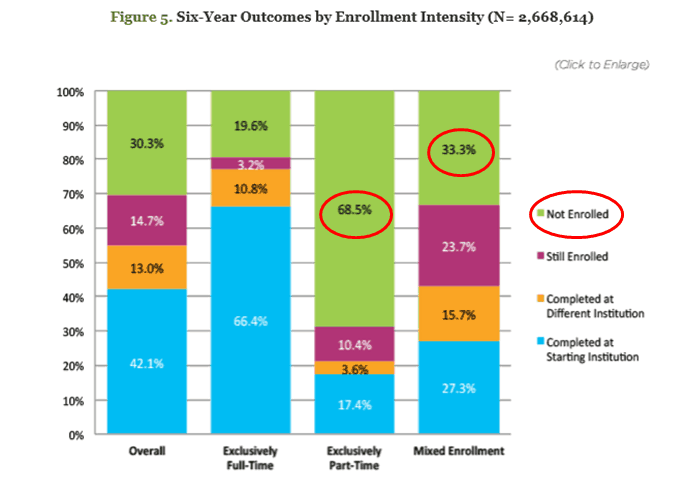
And then we see how age plays out with regard to retention, with older students struggling the most to stay in school and see their training through to completion – another highly relevant factor as mature, non-traditional students fast become a larger pool of prospective applicants for colleges and universities.

The NCS report offers numerous other lenses through which to analyze the problem of student retention, persistence, and achievement, underscoring the enormous importance of relationship-building for schools. With so much emphasis on recruitment and enrollment – of simply getting students through the front door – it’s easy to lose sight of the end goal, which is to guide those same students successfully through to graduation. And in many ways, this is a much more complex task.
This post offers ideas for fostering the kinds of supportive connections students need to stay enrolled and thrive at your institution, addressing both academic and non-academic challenges.
We’ll look at examples from leading schools, and discuss the digital tools and approaches your team could leverage to target your own unique retention challenges.
1. Create Purpose-driven, Supportive Student Communities Online
Why is helping students connect with one another online important for retention? Because thriving, purpose-driven communities help students form positive relationships with like-minded peers – and draw support from those relationships during challenging times at school. According to the NSSE, supportive, encouraging interactions with peers on campus is a key “engagement indicator” and critical factor in student retention. Go a step further and extend your campus-based student groups into digital spaces, where you can promote membership to an even wider audience.
Harvard’s done a great job of inviting students to share personal stories and connect with one another online through its First Generation Student Union project. Harvard recognizes that first gen’s represent a growing share of its (and many other institutions’) student population, and that first generation students are particularly vulnerable to academic pressure and financial challenges (the two top contributors to drop out rates).
Here’s a look at the Harvard First Generation Student web page:

The First Generation Student Union pledges its commitment to the “welfare and community representation of first generation students at Harvard” – and they achieve that goal by giving voice to that community online in a variety of ways. Here’s a Facebook post under the Union’s student-led #primuspride campaign, which highlights the struggles, accomplishments, and everyday lives of current first-gen students at Harvard – in their own words and images.
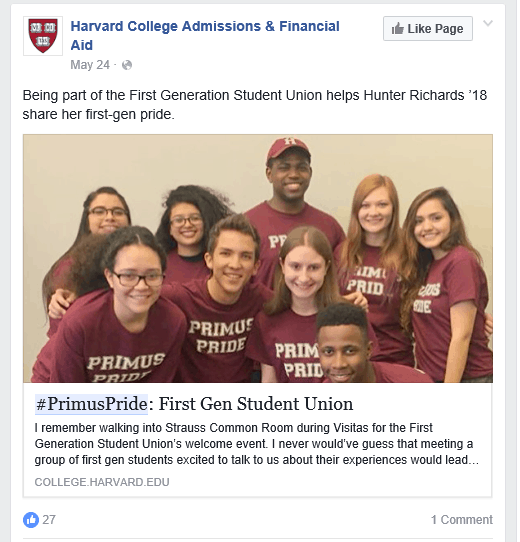
And here’s a post celebrating a first-gen student who has won a prestigious fellowship, accompanied by an out-pouring of support from fellow community-members. This is precisely the kind of encouragement students need to feel seen, heard, and at home at your school – which in turn goes a long way toward keeping them enrolled.

Wondering how to get started with a similar online group initiative? Focus on student personas you know are most at risk for dropping out at your institution. In Harvard’s case, it’s first generation students, but at your school it may be online students or part-time mature students juggling classes with jobs and family. Look closely at the challenges and pain-points of your target personas, at the specific factors that could jeopardize their capacity or willingness to stay enrolled.
The goal is to create personalized spaces online where these students can build their own community of support. Your school could ask a few ambassadors to get the ball rolling in terms of content (which is what Harvard has done), and to play a key role in encouraging their peers to get involved, contribute stories, share accomplishments, and provide encouragement during difficult times.
2. Promote Your Campus Support Services Consistently & Creatively
It’s not enough to list your campus support services on your school website, or mention them from time to time on your social media channels.
Important resources, such as academic counselling, free tutoring, career planning, and alumni mentorship should be showcased regularly – and creatively – with updates, reminders, and stories of student involvement.
Students often need encouragement to seek out help. Making your campus services more visible and approachable online is an important first step to reaching out to and connecting with students at risk of dropping out.
Money concerns, workload anxiety, and feeling overwhelmed in the face of new challenges are three of the top 5 reasons students drop out of college. It’s crucial for schools to highlight the availability – and social acceptability – of seeking help from official campus support organizations. If these resources are never talked about online in ways that normalize and encourage participation, students tend to feel embarrassed to seek them out, or are simply unaware of their existence.
Here’s a great idea from the Ontario College of Art and Design (OCAD), who uses Facebook to promote the wide range of services offered by the campus Health and Wellness Centre. In this post, OCAD is welcoming students to come and de-stress around exam time with free chair massages, free healthy snacks, visits with the resident therapy dog, free guided yoga, and more. This isn’t your typical, dry “come and speak with a counsellor” message – there’s really something for everyone in the offer, and it’s delivered in a light-hearted way that reduces the stigma around seeking help for stress and anxiety:


Advanced tip:
To highlight your campus support services in genuine and meaningful ways, regularly post stories of students who have leveraged these resources to their advantage, incorporating it into your larger content strategy and development plan. From seeking help with finances or exam stress, to receiving assistance with a research project – ask students to contribute anecdotes (mini blog posts, videos, etc.) of how your supportive staff helped them face a challenge, or relieve a source of anxiety.
Ryerson University pulls this off quite well by running a blog post series on financial management, combining expert advice with real student stories in ways that will resonate with (rather than “lecture”) students. Ryerson calls this campaign #RUMONEYSMART, cleverly integrating the university’s initials into the hashtag:

3. Offer a New Student Orientation App
The stats are bleak on freshman retention rates. In the U.S., as many as one in three first year students drop out before reaching year two. In the UK, drop-out rates among freshman have increased for the first time in four years – from 5.7% to 6%. That figure moves up to 8.2% among students from disadvantaged backgrounds.
A survey of 1200 college “freshers” in the UK found that a whopping 27% were contemplating withdrawing from their institution during the summer break before year two.
What’s contributing to this first-year drop-out phenomenon? In many cases, students are buckling under the pressures of post-secondary life: adjusting to a new environment, juggling a busier schedule, keeping up with important deadlines, and managing higher academic expectations.
Developing a new student orientation app is one way your school can take the edge off transitioning to college or university. It’s not a cure-all for the emotional ups and downs of freshman life, but it can certainly help new students manage those crucial early weeks with reminders, maps, event schedules, links to social media freshman groups, and other tools that help newcomers feel less overwhelmed. Apps can also serve as an important element of branding for schools, helping to further promote your school’s unique identity and culture among new students from day one.
Here’s a good example from the University of Michigan, whose app is specifically designed to help freshman take control and stay on track during orientation:
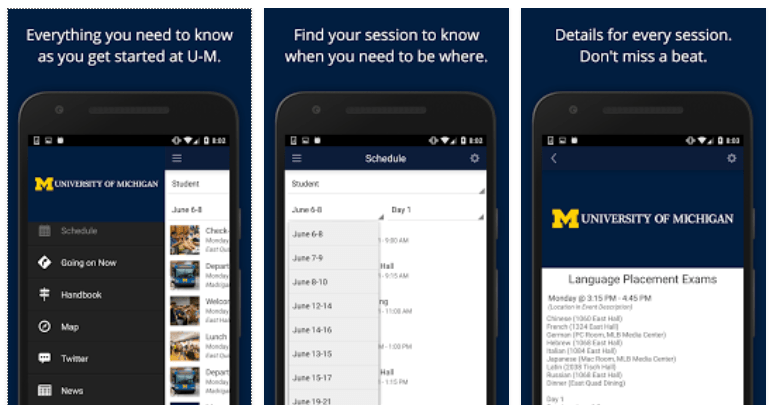
4. Use Automated Software for Early Risk-Detection & Intervention
For struggling students, the downward spiral toward dropping out can happen quite quickly. For example, a few missed classes leads to a failed term paper, which leads to a poor midterm grade, which leads to a lost scholarship, which leads to financial roadblocks, which leads to withdrawal from the program.
Recognizing those early warning signs and intervening right away is key to helping students cope with setbacks, correct misguided habits, and identify helpful strategies for staying in – and thriving at – school.
But when you’ve got thousands of students, and no streamlined way to track and act upon those early warning signs, timely intervention can seem impossible.
This is where automated retention software enters the picture, helping educational institutions better predict and respond to at-risk behaviors that typically lead to dropping out.
There are several tools to choose from. One option, Persistence Plus, uses a “behavioral nudging model” to deliver text messages to students at just the right time, reminding them to study for an upcoming test, begin working on an assignment, take note of an approaching project deadline, etc. These messages are customized to each student’s profile and the real-time responses each one provides regarding their personal challenges and aspirations. The goal is to provide timely, targeted, personalized support to students who are struggling to keep up with the demands of college-level academics. Clients of Persistence Plus include Middlesex Community College and the University of Washington (Tacoma), and the reported results are quite encouraging:
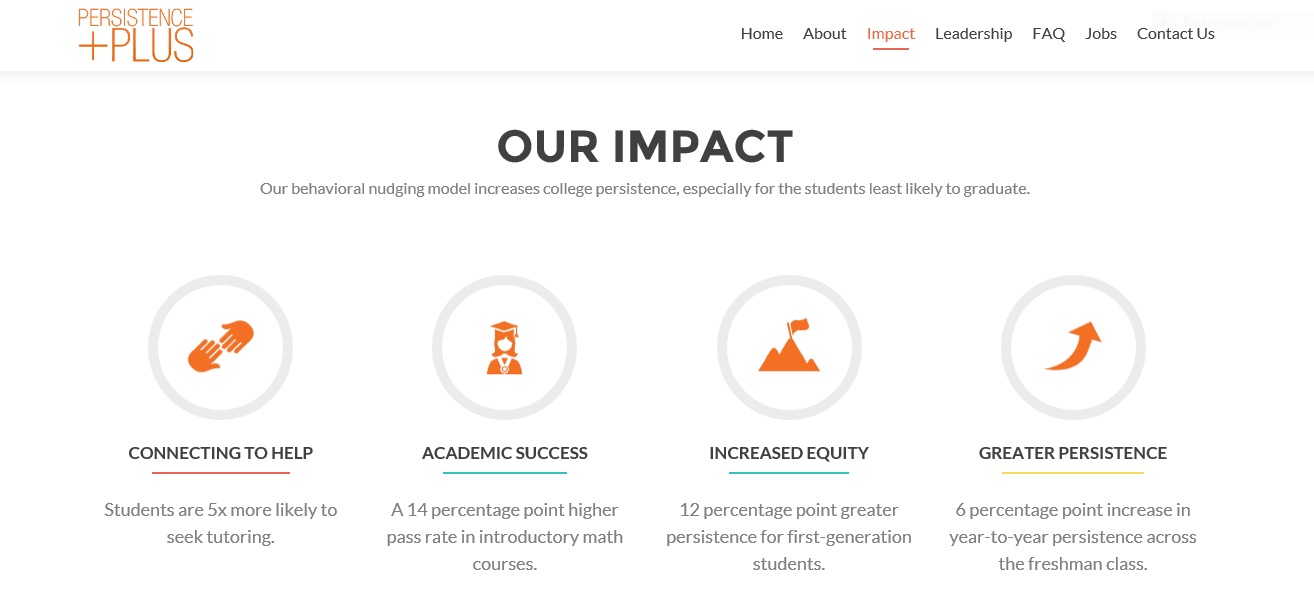
Starfish is another platform that strives to identify and intervene in high-risk situations early on, to help students stay on track. Once synced with your school’s data systems, Starfish can send out messages to let students know you’re concerned about their academic performance, or to congratulate them (send what Starfish calls a “kudo”) for a job well done.
Students can also book advising, tutoring, and financial aid appointments through the system. Integrated solutions like Starfish can go a long way toward stopping that rapid descent down the drop-out spiral that claims so many college and university students, particularly in their freshman year.

5. Create Opportunities to Engage with Alumni Online
While on-campus career fairs and student-alumni mentoring sessions are extremely valuable, it’s important to note that not all students will be able to attend these events. Others will simply feel too shy to approach an alum with their questions or percolating fears. Nonetheless, research has shown just how important mentorship is to both student recruitment and student retention. Individuals who feel uncertain about their program choice and unsure of their capacity to secure employment after graduation are at high risk for dropping out. Crises of confidence put the expense and effort of earning the degree into question, which in turn jeopardizes academic performance and justifies withdrawal.
Why not offer ways to engage meaningfully with participating alumni online? And then promote those exchanges across your marketing channels to get the word out that you offer students real-world solutions and actionable advice – from people who have actually been in their shoes.
Here’s a great example from Princeton University, who recently held an alumni-student “chat” event wherein students submitted questions to, and received advice from, grads in their field. Here’s a look at the promotional video on YouTube, which shows just how important is it to intervene swiftly and meaningfully when students are feeling doubtful about their future paths:

Here’s another example from Ivan Allen College (Georgia Tech), who uses Twitter to connect alumni with liberal arts students in search of career advice:
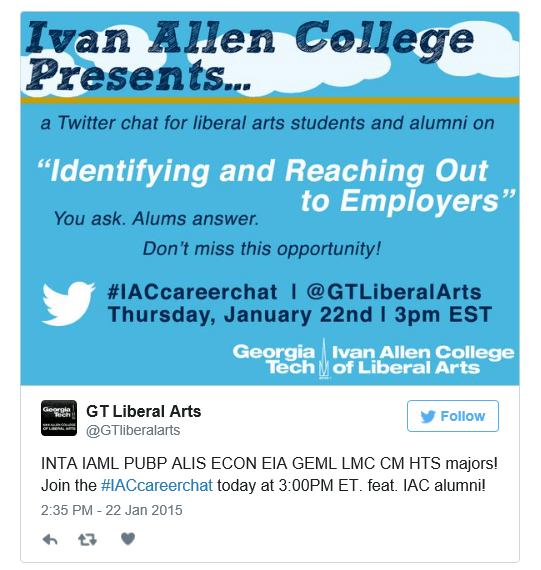
Participating students tweeted questions, and alumni answered them with helpful advice, lessons they’d learned over the years, and encouragement.
While some topics were general in nature, others were very specific to Georgia Tech liberal arts students:
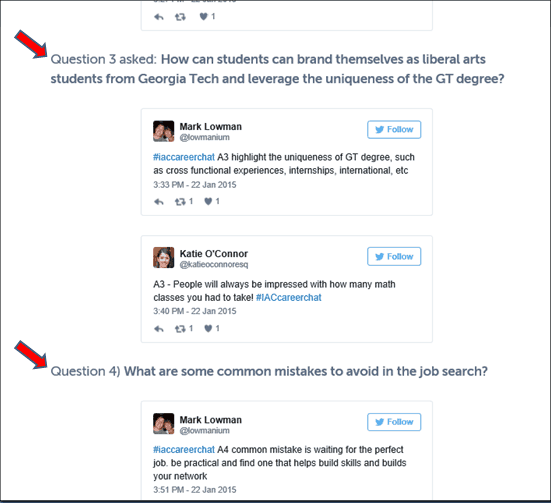
Offering students (particularly populations at high risk for dropping out) opportunities to connect with alumni is crucial for helping them believe in the value of their credential – and that the academic struggle is well worth the end reward. Institutional promises in this regard cannot match the strength of genuine alumni stories, advice, and support.
While drop-outs may still occur, each of these five strategies provides your institution with a way to guard against attrition. By building nurturing relationships with your students and letting them know that your school can help them cope with whatever problems they may be facing, you can provide the support base they need to bounce back and make a success of their education.
Questions or comments about student engagement and retention at your school? Please feel free to share them in the space below!






